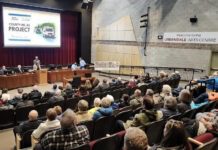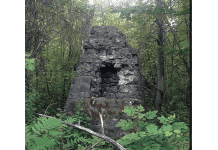A few weeks ago, we profiled the campaign back in 2001-3 to have the memorial cairn at Deek’s Quarry renovated and restored. Since then, thanks to Del Bower, the documentary record of that campaign has been added to significantly, and, perhaps, we can see something constructive happen down the road.
In the meantime, the story of the quarry itself, and the amazing man who owned it, is quite an epic in itself. Harry Falconer McLean was born in Bismarck, North Dakota, in 1883 and grew up to become one of the wealthiest and colourful giants in railway and hydro-electric construction in Canada. One need his companies had was for crushed rock to use as bedding for railway tracks being built across the continent, and, to that end, he opened two quarries, one of which was in Concession 4 of Oxford-on-Rideau Township.
Between 1921 and 1932, the quarry, named after one of his business partners, George “Sam” Deeks, became possibly the largest industrial operation ever seen in this part of the province since the building of the Rideau Canal a century before. When you visit the site today, it is incredible to think that this desolate, abandoned place was once such a hive of activity, with as many as 200 men at one time living and working there through the years.
Chosen by McLean because of its location beside the Canadian Pacific Railway tracks, and the plentiful supply of sandstone in what was then called the “Rock Cut”, Deeks Quarry had no less than fourteen railway spur lines running into it from the main track, and full-scale locomotives working at pulling the crushed rock from the rock crushing machinery to the CPR main line.
In the quarry itself, large quantities of dynamite were used to blast the rock face, and huge machines loaded the large piles of debris into special wagons that were pulled to the crushing machines by saddletank locomotives, which ran on narrow-gauge tracks across the quarry. The amount of heavy machinery needed to keep the quarry in operation needed maintenance and repair, so workshops, welding and forging facilities were built on site, and the noise and dust from the combination of explosions, locomotives, crushing machines and loads of rock being dumped into wagons could be heard for miles around.
It was dangerous work, and there were injuries and deaths throughout the working life of the quarry. But McLean was a good, though unpredictable boss. On the one hand, workers were well-paid for the time, and there were even movie nights held outdoors at the quarry to which people as far away as Kemptville would come. The food was good and plentiful, and passing hoboes riding the rails were welcome to stop and get a good meal on their way through.
On the other hand, “Big Pants” McLean, as he was known, could be unpredictable in his moods. If he wasn’t feeling sociable, there could be a problem. Harold Finnerty, who would become Reeve of Kemptville and bring the water system to the town, once greeted McLean on a visit to the quarry where Harold was working. Instead of answering him, McLean walked up and punched him in the face. Harold left the quarry for good, nursing a black eye.
There is so much to say about McLean that it would take books to cover most of it. In fact, Teresa Charland’s biography, which took a decade to research and write, is a great place to start, and details McLean’s long and lively connection with Merrickville, where he lived for the last decades of his life.
After the quarry shut down in the 1930’s, it was re-opened during World War II as an army supply depot and staging place for war equipment, where trucks, gun carriers, and war materiel were stored before being loaded on to trains en route for Halifax and the ships that would carry it to Britain. Many local men found work at Deek’s Quarry during its eventful life, and there are many around still today who remember McLean himself, his generosity with money, his love of whiskey, his contribution to the life of Merrickville and its residents. It was there he died in 1961. More will be written about the man in later issues.
This is, naturally, only a very brief look at Deek’s Quarry and its larger- than-life owner (McLean was six foot four inches in height). The story is as large as McLean’s legend, and just as colourful. The cairn he built at each of the work sites where his workers were injured and died are important memorials of the times and the men, and the man who brought it all about. It emphasises the significance of these stone monuments and the need to keep the memory of almost forgotten times alive. Deeks Quarry was a huge part of the industrial history of, not just North Grenville and Merrickville-Wolford, but the province and the country.







